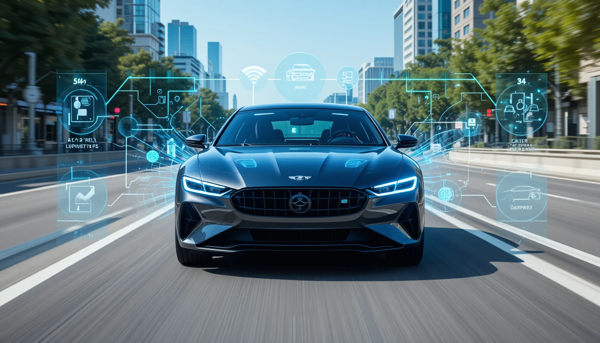Driving Tips
Modern Car Technologies Drivers Should Have to Prevent Accidents

Modern Car Technologies Drivers Should Have to prevent crashes, boost safety, and enjoy smarter driving with today’s top ADAS features.
Advanced driver assistance systems (ADAS) can potentially reduce the likelihood of experiencing a traffic collision that can cause vehicle damage, personal injury, and death. Depending on the manufacturer, ADAS technologies have varying capabilities that can aid, warn, or assist drivers in avoiding mishaps that can cause auto accidents. Being oblivious to what modern assistive safety features include and the correct use of these systems can be a fatal mistake.
Learn more about driver assistance technologies, the levels of driving automation, how these systems can help you prevent auto accidents, and what you should know about these technologies when buying your next vehicle.
Levels Of Driving Automation
Six levels of driving automation were created by SAE International, an organization that focuses on global transport industries such as aerospace, automotive, and commercial vehicles. Levels of automation in vehicles can prevent car accidents by reducing human error and enhancing a driver’s situational awareness.
Level 0: No Driving Automation
At this level, vehicles completely lack any driving automation technology, so the driver must remain engaged and is entirely responsible for operating the vehicle. Drivers must perform actions such as braking, steering, accelerating, parking, and any other necessary maneuvers or actions to drive or halt the vehicle.
Momentary driver assistance features in Level O vehicles that help prevent car accidents include:
- automatic emergency braking
- forward collision warning
- lane departure warning.
Level 1: Driver Assistance
Level 1 driver assistance systems aren’t considered autonomous technology. These automotive systems provide continuous assistance with acceleration, braking, or steering. Adaptive cruise control (ACC) and lane-keeping assistance (LKA) are Level 1 driver assistance technologies that can help prevent car accidents by assisting the driver with maintaining a safe following distance by automatically adjusting the vehicle’s speed to and staying centered within lane boundaries.
Level 2: Partial
Vehicles provide partial automation at level 2. Vehicle systems continuously help drivers and are typically equipped with advanced driver assistance systems (ADAS) that can take control over acceleration, braking, and steering. Tesla Motors pioneered its first version of Autopilot, a Level 2 partial driving automation technology, in 2014. This feature was later developed to support autonomous steering, braking, speed adjustment, and parking capabilities. Tesla’s full self-driving beta (FSD Beta) software was released in October 2020 and continues to release updates.
Level 3: Conditional
At Level 3, vehicles autonomously handle all driving tasks. However, drivers must always be available to take the wheel to resume all aspects of driving if advanced driver assistance systems (ADAS) can no longer operate, require assistance, or abruptly stop functioning effectively.
Level 4: High
At this level, these self-driving vehicles can autonomously transport passengers who do not need to be engaged or ready to take control of the vehicle. Autonomous vehicle systems are completely responsible for all driving and navigational tasks. However, these systems are restricted to specific geographic locations and can’t operate during inclement weather conditions.
Level 5: Full
At Level 5, the system can operate the vehicle universally, under all conditions, and on all roadways, as all driving tasks are handled while the driver is not needed to maneuver the vehicle. Like something out of a futuristic Sci-Fi movie, passengers can effortlessly set their location and can work, sleep, watch movies, and play games while they wait for the vehicle to arrive at their destination.
Most cars and trucks on the road today feature limited levels of autonomy within Levels 0 to 2. While Level 3 to 5 technologies are not available on today’s vehicles for consumer purchase, they are in the experimental stages with companies such as Audi, Honda, and Mercedes-Benz. As the automotive tech sector expands, there will be continuous investment into safe testing, development, and validation of automated driving systems.
Prevent Car Accidents with Advanced Driver Assistance System Technology
Advanced driver assistance system (ADAS) technologies are meant to help the driver reduce their driving risk. For those looking to purchase a new or used vehicle, it can be overwhelming as different manufacturers use different names for the safety features and technologies.
New advanced car safety features are being introduced on vehicles every day. Common driver assistance technologies that are present in modern vehicles include:
- Automatic High Beams: Based on lighting conditions and traffic, this feature automatically switches the vehicle’s headlights between low and high beams when an oncoming vehicle approaches
- Rearview Video System: Allows the driver to see clearly behind the vehicle when in reverse
- Forward Collision Warning: Gives a warning to the driver when a potential collision with a vehicle is detected.
- Lane Departure Warning: Monitors the vehicle’s position within the driving lane. The driver is alerted as the vehicle approaches or crosses lane markers.
- Blind Spot Intervention: Warns of a vehicle in the driver’s blind spot. If the driver ignores the warning, the system activates and gently applies brakes or provides steering to guide the vehicle to its lane and avoid an accident.
- Automatic Emergency Braking: Both dynamic brake support and crash imminent braking work simultaneously to apply brakes automatically when a forward facing collision is impending.
- Adaptive Cruise Control: The vehicle’s speed is automatically adjusted to keep a pre-set distance from the vehicle in front of it.
- Lane Keeping Assistance: The system automatically and gently steers to prevent the vehicle from departing the lane.
To prevent a car accident, driver-assistance technologies rely on the driver to pay attention to their surroundings and take over if a feature fails to perform. Note that some driver assistance technologies are designed to warn you if you’re at risk of an impending collision, while others are designed to take action to prevent a crash. Review your vehicle’s owner’s manual to find more in-depth information on its technology and safety features.
FAQs: Modern Car Technologies
1. What are the best car safety features today?
The top safety features are automatic emergency braking and lane keeping assistance. Blind spot intervention is also key. These features make driving safer and are now common in new cars.
2. How does ADAS help prevent car accidents?
ADAS alerts drivers to dangers and helps with braking and steering. It cuts down on mistakes that cause crashes. Features like adaptive cruise control and lane departure warning are very important.
3. What is the difference between Level 1 and 2?
Level 1 helps with one thing like steering or braking. Level 2 does more, like steering and controlling speed at once. But, the driver must always be ready to take control.
4. Which cars have blind spot warning systems?
Cars from Honda, Toyota, and Ford often have blind spot warning systems. This feature warns drivers of cars in other lanes. Some systems even steer to avoid crashes.
5. Do all new cars come with ADAS features?
Not every new car has all ADAS features, but most have basic ones like forward collision warning. More advanced tech is found in higher trims and newer models. Always check the car’s specs before you buy.
-

 Auto Lease Rentals4 weeks ago
Auto Lease Rentals4 weeks agoZero Down Car Lease Deals – Best Offers You’ll Love
-

 Auto Lease Rentals4 weeks ago
Auto Lease Rentals4 weeks agoWhat Is a High Mileage Lease? Smart Savings & Stress-Free
-

 Auto Loans3 weeks ago
Auto Loans3 weeks agoHow to Get Preapproved for Car Loan – Proven & Stress-Free
-

 Auto Loans3 weeks ago
Auto Loans3 weeks agoCar Loan Calculator With Trade In Value – Instant Savings Boost!






